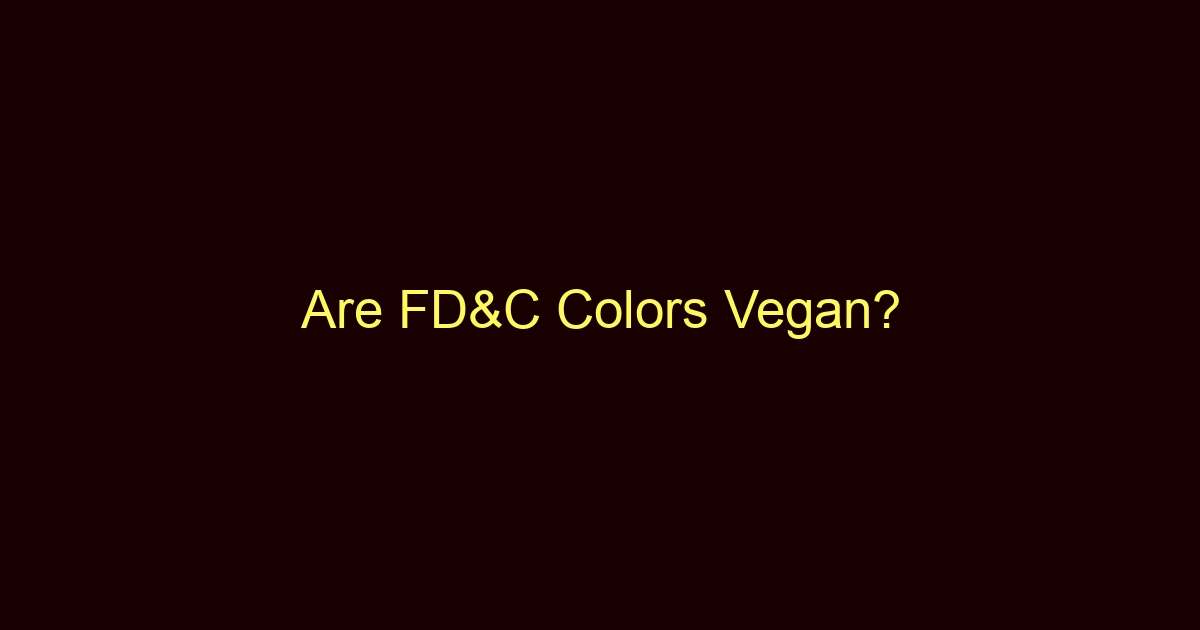FD&C Colors, often seen on the ingredient lists of our everyday food and cosmetic products, can be a point of contention, especially for those following a vegan lifestyle. Let’s explore what these colors are, their origins, and their vegan status.
What are FD&C Colors?
FD&C stands for Food, Drug, and Cosmetics. FD&C colors are a collection of synthetic (artificial) food dyes approved by the US Food and Drug Administration (FDA) for use in foods, drugs, and cosmetic products. They are commonly used to enhance the color of a product, making it visually appealing to consumers.
These dyes, regulated and certified by the FDA, are numbered for identification. For example, FD&C Red No. 40 and FD&C Yellow No. 5 are common colors you might see on a product label. Despite their synthetic origins, they play a significant role in our perception and acceptance of food and cosmetic products.
What are FD&C Colors Made Of?
FD&C colors are made from petroleum or coal tar sources, which are processed and purified to derive various color pigments. This makes them distinctly different from natural food colorings derived from plants, animals, minerals, or other natural sources. It’s important to note that while their production doesn’t directly involve animal products, the process does rely on non-renewable resources, which might not align with the environmental aspect of veganism for some individuals.
What FD&C Colors are Used For
FD&C Colors are primarily used to add color to food, drugs, and cosmetic products. Their role is to enhance the visual appeal of these products, making them more enticing to consumers. For instance, without these dyes, your favorite soda or candy might not have the vibrant color you’re familiar with.
What Products Contain FD&C Colors
FD&C Colors are found in a variety of products ranging from food and beverages to cosmetics and pharmaceuticals. This includes sodas, candies, packaged snacks, soaps, shampoos, and even certain medications. If a product’s color appears brighter or more vibrant than you’d expect, it’s likely FD&C colors are involved.
Are FD&C Colors Vegan?
Yes, FD&C Colors are considered vegan because their production does not involve the use of animal products or by-products. However, some vegans may choose to avoid them due to concerns about animal testing or the environmental implications of their petroleum-based origins.
Can Vegans Use Products Containing FD&C Colors?
From a strict ingredient standpoint, yes, vegans can use products containing FD&C colors. They are synthetic compounds derived from non-animal sources. However, as with any product, individual comfort levels and personal interpretations of what it means to be vegan can vary. Some vegans might choose to avoid these dyes due to their artificial nature, their origins in the petroleum industry, or the fact that they have been tested on animals in the past.
Health Concerns Associated with FD&C Colors
Despite being approved by the FDA, FD&C colors have faced scrutiny due to potential health concerns. Some studies suggest a link between artificial food dyes and hyperactivity in children, while others have raised concerns about potential carcinogenic effects. However, these effects are not conclusively proven and are often associated with high levels of consumption.
Are FD&C Colors Safe for All Dietary Needs?
In general, FD&C colors are considered safe for consumption by the general population. However, certain individuals may have allergic reactions or sensitivity to specific dyes. It’s always a good practice to check labels and consult a healthcare provider if you have concerns.
Natural Alternatives to FD&C Colors
For those uncomfortable with the use of FD&C Colors, natural alternatives do exist. These are derived from plants, minerals, or other natural resources and offer a way to add color to food without the use of synthetic dyes. Examples include beetroot powder, turmeric, and spirulina.
The Impact of FD&C Colors on the Environment
As FD&C Colors are petroleum-based, their production contributes to the depletion of non-renewable resources and could potentially cause environmental harm due to the associated extraction and refinement processes. This is a concern shared by many vegans, who often value environmental sustainability as part of their lifestyle choices.
Final Thoughts
FD&C Colors, while vegan in terms of their ingredients, may not align with all aspects of veganism due to concerns about their petroleum-based origins and past involvement in animal testing. For individuals who prefer to avoid synthetic dyes, natural alternatives are available. As always, it’s essential to read labels carefully and make choices that align with your personal beliefs and health needs.

